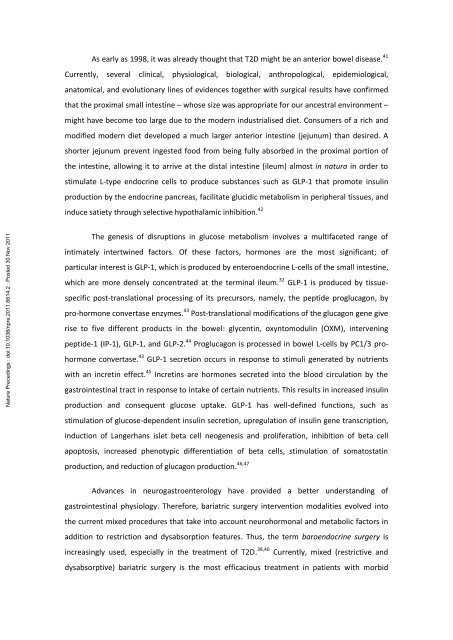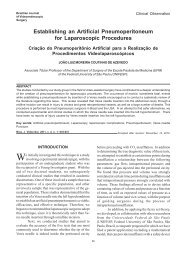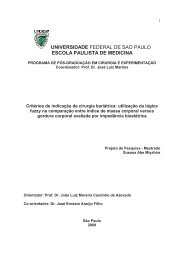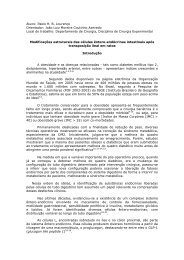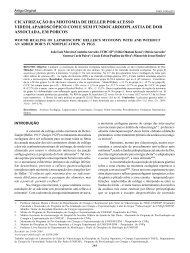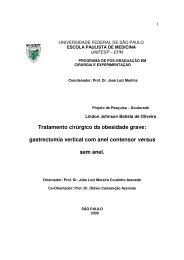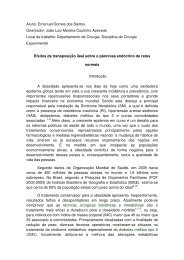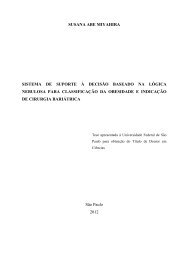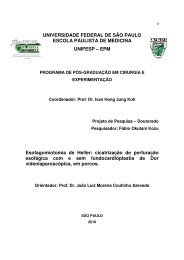Isolated ileal interposition in enteroendocrine L cells differentiation
Isolated ileal interposition in enteroendocrine L cells differentiation
Isolated ileal interposition in enteroendocrine L cells differentiation
Create successful ePaper yourself
Turn your PDF publications into a flip-book with our unique Google optimized e-Paper software.
As early as 1998, it was already thought that T2D might be an anterior bowel disease. 41<br />
Currently, several cl<strong>in</strong>ical, physiological, biological, anthropological, epidemiological,<br />
anatomical, and evolutionary l<strong>in</strong>es of evidences together with surgical results have confirmed<br />
that the proximal small <strong>in</strong>test<strong>in</strong>e – whose size was appropriate for our ancestral environment –<br />
might have become too large due to the modern <strong>in</strong>dustrialised diet. Consumers of a rich and<br />
modified modern diet developed a much larger anterior <strong>in</strong>test<strong>in</strong>e (jejunum) than desired. A<br />
shorter jejunum prevent <strong>in</strong>gested food from be<strong>in</strong>g fully absorbed <strong>in</strong> the proximal portion of<br />
the <strong>in</strong>test<strong>in</strong>e, allow<strong>in</strong>g it to arrive at the distal <strong>in</strong>test<strong>in</strong>e (ileum) almost <strong>in</strong> natura <strong>in</strong> order to<br />
stimulate L-type endocr<strong>in</strong>e <strong>cells</strong> to produce substances such as GLP-1 that promote <strong>in</strong>sul<strong>in</strong><br />
production by the endocr<strong>in</strong>e pancreas, facilitate glucidic metabolism <strong>in</strong> peripheral tissues, and<br />
<strong>in</strong>duce satiety through selective hypothalamic <strong>in</strong>hibition. 42<br />
Nature Preced<strong>in</strong>gs : doi:10.1038/npre.2011.6614.2 : Posted 30 Nov 2011<br />
The genesis of disruptions <strong>in</strong> glucose metabolism <strong>in</strong>volves a multifaceted range of<br />
<strong>in</strong>timately <strong>in</strong>tertw<strong>in</strong>ed factors. Of these factors, hormones are the most significant; of<br />
particular <strong>in</strong>terest is GLP-1, which is produced by enteroendocr<strong>in</strong>e L-<strong>cells</strong> of the small <strong>in</strong>test<strong>in</strong>e,<br />
which are more densely concentrated at the term<strong>in</strong>al ileum. 32 GLP-1 is produced by tissuespecific<br />
post-translational process<strong>in</strong>g of its precursors, namely, the peptide proglucagon, by<br />
pro-hormone convertase enzymes. 43 Post-translational modifications of the glucagon gene give<br />
rise to five different products <strong>in</strong> the bowel: glycent<strong>in</strong>, oxyntomodul<strong>in</strong> (OXM), <strong>in</strong>terven<strong>in</strong>g<br />
peptide-1 (IP-1), GLP-1, and GLP-2. 44 Proglucagon is processed <strong>in</strong> bowel L-<strong>cells</strong> by PC1/3 prohormone<br />
convertase. 43 GLP-1 secretion occurs <strong>in</strong> response to stimuli generated by nutrients<br />
with an <strong>in</strong>cret<strong>in</strong> effect. 45 Incret<strong>in</strong>s are hormones secreted <strong>in</strong>to the blood circulation by the<br />
gastro<strong>in</strong>test<strong>in</strong>al tract <strong>in</strong> response to <strong>in</strong>take of certa<strong>in</strong> nutrients. This results <strong>in</strong> <strong>in</strong>creased <strong>in</strong>sul<strong>in</strong><br />
production and consequent glucose uptake. GLP-1 has well-def<strong>in</strong>ed functions, such as<br />
stimulation of glucose-dependent <strong>in</strong>sul<strong>in</strong> secretion, upregulation of <strong>in</strong>sul<strong>in</strong> gene transcription,<br />
<strong>in</strong>duction of Langerhans islet beta cell neogenesis and proliferation, <strong>in</strong>hibition of beta cell<br />
apoptosis, <strong>in</strong>creased phenotypic <strong>differentiation</strong> of beta <strong>cells</strong>, stimulation of somatostat<strong>in</strong><br />
production, and reduction of glucagon production. 46,47<br />
Advances <strong>in</strong> neurogastroenterology have provided a better understand<strong>in</strong>g of<br />
gastro<strong>in</strong>test<strong>in</strong>al physiology. Therefore, bariatric surgery <strong>in</strong>tervention modalities evolved <strong>in</strong>to<br />
the current mixed procedures that take <strong>in</strong>to account neurohormonal and metabolic factors <strong>in</strong><br />
addition to restriction and dysabsorption features. Thus, the term baroendocr<strong>in</strong>e surgery is<br />
<strong>in</strong>creas<strong>in</strong>gly used, especially <strong>in</strong> the treatment of T2D. 38,40 Currently, mixed (restrictive and<br />
dysabsorptive) bariatric surgery is the most efficacious treatment <strong>in</strong> patients with morbid


